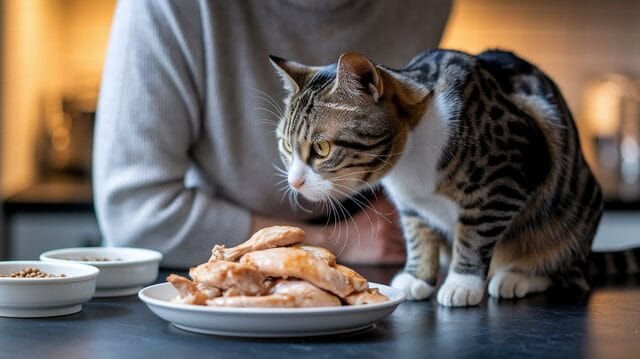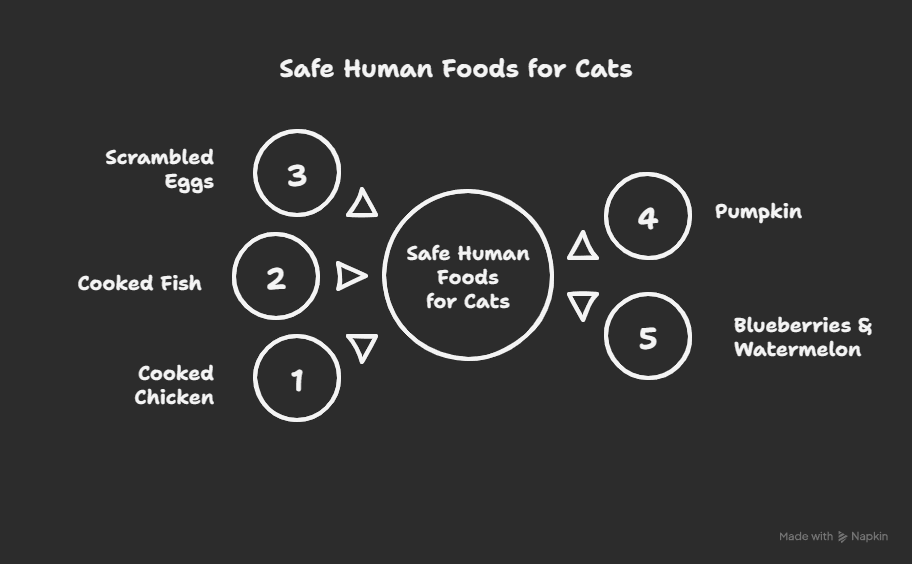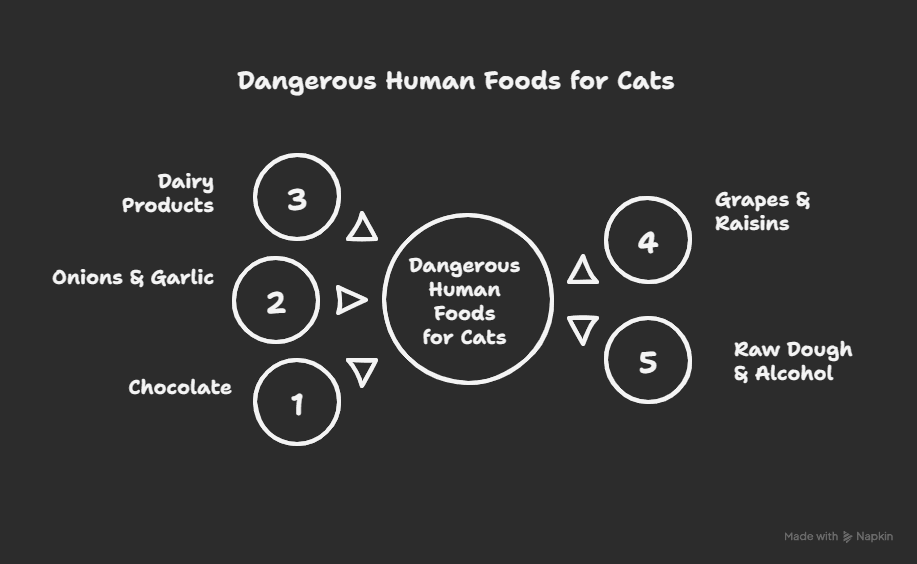
Introduction
Have you ever been eating and noticed your cat staring at you, waiting for a bite? We’ve all been there! But before you share your meal, you might wonder, “Can cats eat human food?” The truth is, not everything we eat is safe for cats.
Some human foods are harmless, even healthy, while others can be toxic and life-threatening. So, how do you know what’s safe and what’s dangerous?
In this guide, we’ll go over 5 safe human foods you can give your cat and 5 foods you should avoid at all costs.
🐾 5 Safe Human Foods for Cats

Not all human food is bad for cats! Here are some vet-approved treats you can occasionally share with your feline friend.
1. Cooked Chicken (✅ Safe)
Cats are obligate carnivores, meaning they need meat to stay healthy. Cooked chicken is one of the best human foods for cats because it provides high-quality protein.
✔ How to serve: Plain, fully cooked, with no seasoning or sauces.
2. Cooked Fish (✅ Safe in Moderation)
Fish like salmon, tuna, and sardines are rich in Omega-3 fatty acids, which promote a healthy coat and skin. However, too much fish can be harmful due to mercury and heavy metals.
✔ How to serve: Occasional cooked fish (avoid raw fish, which can contain bacteria and parasites).
🚫 Avoid: Canned fish with added salt or oil.
3. Scrambled Eggs (✅ Safe in Moderation)
Eggs are packed with protein and vitamins, making them a great occasional snack for cats.
✔ How to serve: Scrambled or boiled, fully cooked, no salt or butter.
🚫 Avoid: Raw eggs (they contain avidin, which blocks vitamin B absorption).
4. Pumpkin (✅ Safe & Good for Digestion)
Pumpkin is a fiber-rich food that can help with constipation, diarrhea, and hairball control.
✔ How to serve: Plain, canned pumpkin (no added sugar, spices, or pie filling).
🚫 Avoid: Pumpkin pie filling, which contains nutmeg and sugar.
5. Blueberries & Watermelon (✅ Safe in Small Amounts)
Fruits aren’t a necessary part of a cat’s diet, but some can be fun, low-calorie treats. Blueberries and watermelon are packed with antioxidants and vitamins.
✔ How to serve: Tiny pieces, seedless and in moderation.
🚫 Avoid: Grapes, raisins, and citrus fruits (they’re toxic to cats).
🚨 5 Dangerous Human Foods for Cats

Now that we’ve covered some safe options, let’s talk about the foods you should NEVER feed your cat.
1. Chocolate (❌ Toxic – Can Be Deadly!)
Chocolate contains theobromine and caffeine, which are highly toxic to cats. Even small amounts can lead to vomiting, tremors, seizures, and even death.
🚨 Signs of poisoning: Hyperactivity, rapid heartbeat, muscle tremors, seizures.
🚫 Avoid: ALL chocolate, especially dark and baking chocolate (they contain the highest levels of theobromine).
2. Onions & Garlic (❌ Highly Toxic Even in Small Amounts)
Onions, garlic, chives, and leeks can cause severe anemia by destroying red blood cells. Even small amounts can be dangerous.
🚨 Signs of poisoning: Lethargy, pale gums, weakness, loss of appetite.
🚫 Avoid: Onion powder in processed foods, garlic-seasoned meats, baby food containing onion or garlic.
3. Dairy Products (❌ Most Cats Are Lactose Intolerant)
Contrary to popular belief, milk is NOT good for cats. Many adult cats are lactose intolerant, meaning they can’t digest dairy properly.
🚨 Symptoms: Diarrhea, stomach pain, bloating.
🚫 Avoid: Milk, cheese, ice cream, yogurt (unless it’s lactose-free).
✔ Safe Alternative: Special lactose-free cat milk available at pet stores.
4. Grapes & Raisins (❌ Can Cause Kidney Failure)
Even one or two grapes or raisins can cause sudden kidney failure in cats. The exact toxin is unknown, but it’s extremely dangerous.
🚨 Signs of poisoning: Vomiting, lethargy, loss of appetite, kidney failure.
🚫 Avoid: All forms of grapes and raisins, including dried fruit and grape juice.
5. Raw Dough & Alcohol (❌ Extremely Dangerous!)
Raw bread dough contains yeast, which ferments in the stomach, causing painful bloating and alcohol poisoning. Even small amounts of alcohol can be deadly to cats.
🚨 Signs of poisoning: Disorientation, vomiting, breathing issues, seizures.
🚫 Avoid: Raw dough, beer, wine, alcohol-based sauces.
🍽️ How to Feed Human Food to Cats Safely
- ✅ Always research before giving human food to your cat.
- ✅ Introduce new foods slowly to check for allergies or stomach issues.
- ✅ Keep human food an occasional treat, not a meal replacement.
- ✅ If in doubt, ask your vet before feeding your cat new foods.
🙋 FAQs: Common Questions About Cats & Human Food
Q1: Can cats eat rice?
✔ Yes, in small amounts. Plain cooked rice is safe and can help with an upset stomach, but it shouldn’t replace cat food.
Q2: Can cats eat peanut butter?
❌ No. Peanut butter is high in fat and may contain artificial sweeteners (like xylitol), which are toxic to cats.
Q3: Can cats eat cheese?
❌ Most cats are lactose intolerant, so cheese can cause stomach upset. If your cat tolerates dairy, give only tiny amounts occasionally.
Q4: Can cats eat bananas?
✔ Yes, but in very small pieces as an occasional treat. Bananas are high in sugar, so they should be given in moderation.
Q5: Can cats eat bread?
✔ Yes, plain bread is not toxic, but it has no nutritional benefits. Avoid buttered or flavored bread.
Also Read - Indoor vs Outdoor Cats - Which Is Better for Your Furry Friend?
Conclusion: Should You Share Your Food with Your Cat?
The short answer? Sometimes. While some human foods are safe for cats, others are toxic and dangerous. The key is to know what’s safe, avoid harmful foods, and always feed in moderation.
🐱 Now It’s Your Turn!
Does your cat beg for human food? What’s their favorite snack? Share your experience in the comments below! 👇🐾




